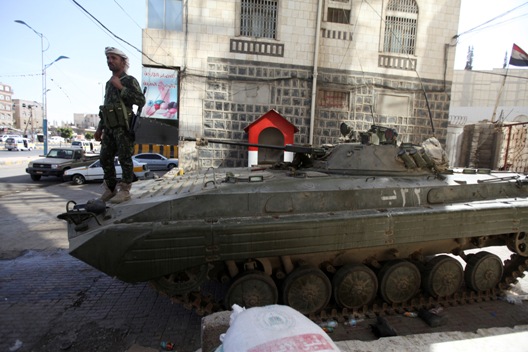 Hope for Yemen’s political transition suffered a major blow over the past two days as Houthi rebels shelled the presidential palace and put President Abdrabbo Mansour Hadi, a key US ally, under house arrest. Yemen’s Information Minister Nadia Sakkaf reported that Hadi had lost all control over the country, including in the capital, Sana’a. The Houthi move comes after months of clashes, protests, and political maneuvering for control over the country. Danya Greenfield, Yemen expert and deputy director of the Atlantic Council’s Rafik Hariri Center for the Middle East, said that Yemen’s devolution into disorder stems in part from the inadequate support provided to the government and the United States’ narrow counterterrorism strategy that focuses primarily on drone strikes against al-Qaeda militants.
Hope for Yemen’s political transition suffered a major blow over the past two days as Houthi rebels shelled the presidential palace and put President Abdrabbo Mansour Hadi, a key US ally, under house arrest. Yemen’s Information Minister Nadia Sakkaf reported that Hadi had lost all control over the country, including in the capital, Sana’a. The Houthi move comes after months of clashes, protests, and political maneuvering for control over the country. Danya Greenfield, Yemen expert and deputy director of the Atlantic Council’s Rafik Hariri Center for the Middle East, said that Yemen’s devolution into disorder stems in part from the inadequate support provided to the government and the United States’ narrow counterterrorism strategy that focuses primarily on drone strikes against al-Qaeda militants.
Greenfield spoke with the New Atlanticist’s editor Ashish Kumar Sen about the latest developments in Yemen, describing the implications of a government collapse on US interests, the flaws in the narrow US approach to counterterrorism, and offering a more comprehensive, long-term strategy to building Yemen’s overall security infrastructure. By ignoring the underlying tribal dynamics, economic needs of ordinary Yemenis, and evolving sectarian volatility, the United States becomes reliant on an unstable security structure to combat al-Qaeda in the Arabian Peninsula (AQAP), a group which takes advantage of localized and national conflicts to recruit new members and forge new alliances with Sunni tribes.
Read the full interview on the New Atlanticist blog: In Yemen, a US Policy Focused on Drones Missed the Roots of Instability and Terror
Image: A Houthi fighter stands atop an armored vehicle, which was seized from the army during recent clashes, outside the house of Yemen's President Abdrabbo Mansour Hadi in Sanaa January 21, 2015. REUTERS/Mohamed al-Sayaghi
